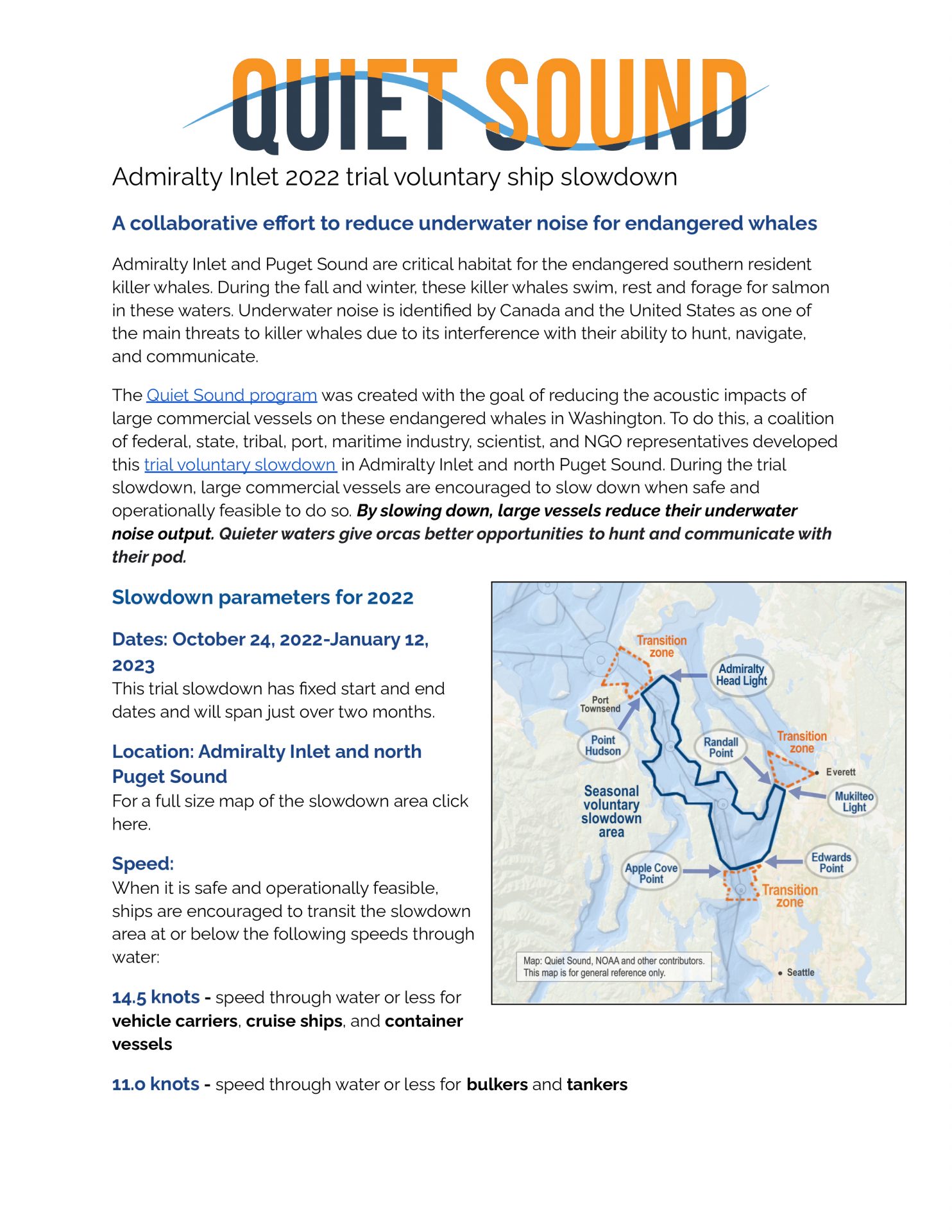2022 Trial Slowdown
Results from the 2022-2023 Trial Slowdown
Admiralty inlet and North Puget Sound 2022 trial Voluntary ship slowdown
A collaborative effort to reduce underwater noise for endangered whales
Admiralty Inlet and Puget Sound are critical habitats for the endangered southern resident killer whales. During the fall and winter, these killer whales swim, rest and forage for salmon in these waters. Underwater noise is identified by Canada and the United States as one of the main threats to killer whales due to its interference with their ability to hunt, navigate, and communicate.
The Quiet Sound program was created with the goal of reducing the acoustic impacts of large commercial vessels on these endangered whales in Washington. To do this, a coalition of federal, state, tribal, port, maritime industry, scientist, and NGO representatives developed this trial voluntary slowdown in Admiralty Inlet and north Puget Sound. During the trial slowdown, large commercial vessels are encouraged to slow down when safe and operationally feasible to do so. By slowing down, large vessels reduce their underwater noise output. Quieter waters give orcas better opportunities to hunt and communicate with their pod.
For further details on the Quiet Sound program, the development and implementation of the voluntary vessel slowdown trial, as well as the results of the 2022-2023 trial, please access the full report here.
Not Currently in Effect

For a full-size map of the slowdown, click here
Slowdown Parameters for 2022
Dates: October 24, 2022-January 12, 2023
Location: Admiralty Inlet and north Puget Sound
The voluntary vessel slowdown trial takes place in the inbound and outbound lanes of the shipping lanes within these boundaries:
Northwest boundary of the slowdown: a line drawn between Pt Hudson (48.117264, -122.748907) and Admiralty Head (48.154217, -122.679503)
Northeast boundary of the slowdown: a line drawn between Randall Pt (47.983237, -122.352871) and the Mukilteo Lighthouse (47.948181, -122.308043)
Southern boundary of the slowdown: a line drawn between Apple Cove Pt (47.815535, -122.480885) and Edwards Pt (47.803340, -122.394924)
The slowdown area excludes Hood Canal.
For a full-size map of the slowdown area click here.
Speed:
When it is safe and operationally feasible, ships are encouraged to transit the slowdown area at or below the following speeds through water:
- 14.5 knots – speed through water or less for vehicle carriers, cruise ships, and container vessels
- 11.o knots – speed through water or less for bulkers and tankers
Estimated transit time impacts:
Transiting through the slowdown area at the reduced speed could add 10 to 20 minutes to the total transit time, depending on the vessel type and water currents.
Benefits to Participants:
Fleets with high rates of participation are eligible for documentation to meet a criterion in the Underwater Noise performance indicator for their Green Marine certification
Watch for whales
Endangered whales can be found outside this slowdown area and in the area beyond the dates of the slowdown. Quiet Sound encourages mariners to sign up for the WhaleReport Alert System to receive text alerts when you are within 10 nm of a verified whale sighting. If you belong to a professional marine organization and are a pilot or member of the bridge crew of a ship, please contact the WRAS Project Manager at WRAS@ocean.org to request access to the WhaleReport Alert System.
How can the public help this initiative?
Members of the public can help commercial mariners avoid whales by reporting whale sightings through:
- Orca Network, www.orcanetwork.org/report-sightings
- The WhaleReport app (available on Apple or Google devices)
- The Whale Alert app (available on Apple or Google devices)
- WhaleReport on the App Store (apple.com)
- WhaleReport – Apps on Google Play
For more information:
- Download the slowdown fact sheet for more details
- Sign up for the Quiet Sound slowdown newsletter here
- Questions? Contact us at info@quietsound.org. Pilots with questions about the slowdown can text or call Quiet Sound at (360) 218-2307 from 8 am to 5 pm Monday through Friday.
- Learn more about concurrent slowdowns for whale protection in Canadian waters on the ECHO site
acknowledgements
Quiet Sound recognizes the essential contributions of the Leadership Committee and working groups who provided input on this first trial slowdown. We also thank the ECHO program for their mentorship in setting up a voluntary slowdown zone. Puget Sound Pilots are playing a pivotal role in the on-water success of this effort. The Marine Exchange of Puget Sound is providing AIS data, and the Marine Exchange and Pacific Merchant Shipping Association have been key partners in communicating the slowdown to the maritime industry.
We thank all the tribal governments who considered our proposal to put forward this program for vessels traveling through their usual and accustomed fishing areas.
Quiet Sound gratefully acknowledges all the partners who are working to provide Washington mariners with real-time whale locations, including: Ocean Wise, Orca Network, Acartia, Conserve.io, and all the members of the public who report sightings.
Funding for this work was provided by the Washington State Legislature, US Environmental Protection Agency, and the National Fish and Wildlife Foundation.


